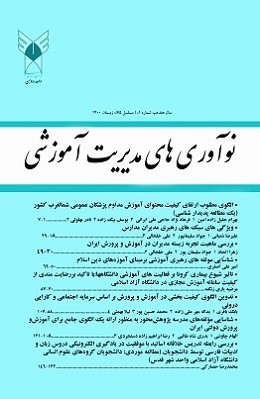شناسایی و ارزیابی موانع تحقق اهداف عملیاتی سند تحول بنیادین آموزش و پرورش از دیدگاه مدیران و معلمان مدارس استان فارس
محورهای موضوعی : مدیریت نوآوری های آموزشیسید احمد مدنی 1 , سمیه کوه پیما رونیزی 2
1 - مدیرگروه
2 -
کلید واژه:
چکیده مقاله :
در جهان دایمـاً دستخوش تغییر امروز، هر جامعه ای نیازمند اجرای اصلاحات در نظام آموزشی خویش است و طبعـاً جوامعی که از شتاب و شدت دگرگونی های بیشتر در عرصه های گوناگون برخوردارند، به این مهم محتاج ترند و کشور و جامعه فعلی ما هم از این قاعده مستثنی نیست. در همین راستا، سند تحول بنیادین نظام آموزش و پرورش ایران در سال 1390 تدوین و به کلیه سازمان های آموزش و پرورش کشور ابلاغ شد اما به اعتقاد بسیاری از کارشناسان، این سند هنوز عملیاتی نشده است. لذا هدف پژوهش حاضر شناسایی و ارزیابی موانع تحقق اهداف عملیاتی سند تحول می باشد. نوع تحقیق از نظر هدف کاربردی و از نظر اجرا توصیفی –پیمایشی می باشد. جامعه آماری شامل مدیران و معلمان استان فارس در سال تحصیلی 97-1396 می باشد که با استفاده از فرمول کوکران 242 نفر به دست آمد. در بخش جمع آوری داده ها از روش میدانی و از پرسشنامه محقق ساخته در 40 گویه با هفت مولفه (موانع فنی، ساختاری، فرهنگی، مدیریتی، مالی و تجهیزات، نیروی انسانی و آمادگی اجتماعی) در قالب طیف هفت درجه ای لیکرت استفاده شد. روایی محتوایی و سازه پرسشنامه تأیید شد. پایایی پرسشنامه موانع تحقق اهداف عملیاتی سند تحول از طریق ضریب آلفای کرونباخ 90/0 برآورد گردید. تحلیل داده ها در سطح توصیفی و استنباطی با استفاده از نرم افزار SPSS و لیزرل انجام شد. یافته ها نشان داد میانگین تمامی مولفه های موانع تحقق اهداف عملیاتی سند تحول از میانگین فرضی 4 کمتر و به نوعی در وضعیت نامطلوب بودند. ضریب همبستگی پیرسون نشان داد بین همه ابعاد و مولفه ها رابطه مثبت و معنادار وجود دارد. همچنین از بین موانع اجرایی اهداف عملیاتی سند تحول، موانع ساختاری و مدیریتی با 83/0 دارای بیشترین بار عاملی و مانع فرهنگی با 51/0 دارای کمترین بار عاملی و وزن بودند.
In a constantly changing world, today every society needs to implement reforms in its educational system, and naturally societies that are more in need of acceleration and intensification of more transformations in various social, cultural and scientific fields and our current country and society are no exception. In this regard, fundamental transformation document on the of Iran's education system was formulated in 2011 year and communicated to all education organizations in the country, but many experts believe that this document has not yet been operational. Therefore, the purpose of this study was identify and assess the barriers to the realization of the operational objectives of the transformational document. The research type is applied in terms of its purpose and is descriptive-survey. The statistical population consisted of managers and teachers of Fars province in 2018-2019 academic year, that due to the extent of Fars Province, this research was carried out in Shiraz and Fasa cities, as the selected cities. The sample size was obtained using Cochran's formula of 242 people. Data were collected using field method and a researcher-made questionnaire in 40 items with 7 components (technical, structural, cultural, managerial, financial and equipment barriers, manpower and social preparedness) in terms of a 7-degree Likert spectrum. Questionnaire content & construction validity confirmed. Questionnaire reliability barriers to the realization operational objectives by using Cronbach Alpha Coefficient estimated equal to 0.90. Data’s analysis done in descriptive & inferential levels by using Spss & Lisrel software’s. The findings showed that the role of all barriers to achieving the operational goals of the transformational document was higher than the average. Also, Pearson correlation coefficient showed that there is a positive and significant relationship between all dimensions and components, in other words, increasing each of these barriers cause to increases other obstacles. Also among operational goals of the transformational document, structural and managerial barriers with 0.83 had the most load factor and cultural barrier with 0.51 having the least factor load and weight.


